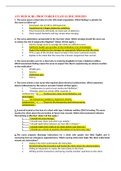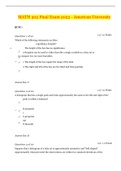-
1. Exam (elaborations) - Ati med surg exam (100% verified questions & answers latest 2020) chamberlain college...
-
2. Exam (elaborations) - Med-surg proctored 2019 ati retake with ngn latest 2023-2024
-
3. Exam (elaborations) - Ati med-surg proctored exam 2020
-
4. Exam (elaborations) - Ati med surg (paeds )exam 2020
-
5. Exam (elaborations) - Med surg 250 test bank for medical-surgical nursing
-
6. Exam (elaborations) - Ati med surg study guide 2020/2021 reliable study document
-
7. Exam (elaborations) - Ati med surg practice questions & answers 2021
-
8. Exam (elaborations) - Nur 232 ati med surg final exam 1 study guide 2020/2021
-
9. Exam (elaborations) - Ati med surg mid-term exam study guide 2021
-
10. Exam (elaborations) - Ati med surg exam quizzes-reliable questions & answers already graded a 2021
-
11. Exam (elaborations) - Ati med surg practice b verified questions & answers
-
12. Exam (elaborations) - Ati med surg proctored study guide- nursing care of children latest update 2021
-
13. Exam (elaborations) - Ati med surg study-ati skills modules study guide 2021
-
14. Exam (elaborations) - Ati med surg study guide - verified study guide 2021
-
15. Exam (elaborations) - Nurs 4110 ati med surg surg test 2 guide questions & answers
-
16. Exam (elaborations) - Assessment of the respiratory system ignatavicius: medical-surgical nursing, 8th edit...
-
17. Exam (elaborations) - Ati med surg final exam questions & answers
-
18. Exam (elaborations) - Ati med-surge 2 exam 2
-
19. Exam (elaborations) - Ati: rn adult medical surgical online practice 2019 a
-
20. Exam (elaborations) - Ati rn adult medical surgical proctored exam 2 revision guide 2019
-
21. Exam (elaborations) - Ati med surg proctored exam (study guide) latest update 2022
-
22. Exam (elaborations) - Ati med surg proctored exam 2019 – (study guide)
-
23. Exam (elaborations) - Ati med surg midterm exam 2021– correct questions & answers
-
24. Exam (elaborations) - Ati med surg proctored exam latest 2021 (study guide) 250 correct questions & answers
-
25. Exam (elaborations) - Ati med-surg proctored exam b 2019 - 90 correct questions & answers
-
26. Exam (elaborations) - Ati med surg / nursing 250 proctored exam 2019 guide - 111 correct questions & answer...
-
27. Exam (elaborations) - Ati med surg proctored final exam 2019 - 50 correct questions & answers
-
28. Exam (elaborations) - Ati med surg proctored exam guide 2020/2021 - correct questions & answers
-
29. Exam (elaborations) - Ati adult med surg exam 1 final (versions 1-4) – study guide 2019
-
30. Exam (elaborations) - Ati med-surg a 2019 exam – study guide / 90 correct questions & answers
-
31. Exam (elaborations) - Ati med surg a 2019 exam – study guide 90 correct questions & answers
-
32. Exam (elaborations) - Ati med surg final exam test bank latest 2021
-
33. Exam (elaborations) - Ati med surg proctored exam – study guide 2019
-
34. Exam (elaborations) - Nr 3447 ati med surg proctored exam – study guide 2020/2021 correct questions & an...
-
35. Exam (elaborations) - Ati med surg 3 proctored exam – study guide 2019 all correct questions & answers
-
36. Exam (elaborations) - Ati rn med surg proctored 2019 exam - study guide / all correct questions & answers
-
37. Exam (elaborations) - Lewis's medical-surgical nursing: assessment and management of clinical problems 11th...
-
38. Exam (elaborations) - Ati med surg proctored exam a & b guide 2020/2021 - correct questions & answers
-
39. Exam (elaborations) - Ati med surg proctored exam – study guide 2022/2023
-
40. Exam (elaborations) - Ati rn adult med surg 2019 exam - study guide / correct questions & answers
-
41. Exam (elaborations) - Ati rn med surg proctored exam - study guide 2021/2022
-
42. Exam (elaborations) - Ati capstone med-surg proctored exam - study guide 2021
-
43. Exam (elaborations) - Ati med surg study guide - lab values
-
44. Exam (elaborations) - Ati med surg proctored 2019 exam study guide / correct questions & answers
-
45. Exam (elaborations) - Ati med surg form a exam review 2019
-
46. Exam (elaborations) - Ati med surg proctored exam 2019 – cardiovascular health study guide
-
47. Exam (elaborations) - Ati med surg proctored study guide 2021/2022 - correct questions & answers with ratio...
-
48. Exam (elaborations) - Ati med surg proctored exam 2021 - oncology study guide
-
49. Exam (elaborations) - Ati med surg proctored 2019 study guide - correct questions & answers
-
50. Exam (elaborations) - Ati med surg proctored exam – study guide management of patients with oral and esop...
-
51. Exam (elaborations) - Ati rn medical-surgical proctored study guide
-
52. Exam (elaborations) - Ati med surg proctored (cardiovascular) study guide
-
53. Exam (elaborations) - Ati med surg final exam study guide 2019
-
54. Exam (elaborations) - Medical surgical nursing notes 2021/2022
-
55. Exam (elaborations) - Ati med surg proctored 2019 exam - study guide
-
56. Exam (elaborations) - Medical surgical nursing 10th edition ignatavicius workman test bank - all chapters 1...
-
57. Exam (elaborations) - Ati med surg final exam – study guide 2021
-
58. Exam (elaborations) - Ati med surg final exam 2019 study guide - questions & answers
-
59. Exam (elaborations) - Ati med surg final exam / ati med surg final exam – study guide (2021) correct ques...
-
60. Exam (elaborations) - Ati med surg proctored exam - 2020 study guide / fluid and electrolytes balance and d...
-
61. Exam (elaborations) - Ati med surg proctored exam 1 - study guide
-
62. Exam (elaborations) - Ati med surg proctored 2019 exam (study guide)
-
63. Exam (elaborations) - Ati med surg proctored retake guide
-
64. Exam (elaborations) - Ati med-surg proctored exam 2019 – study guide
-
65. Exam (elaborations) - Ati med-surg proctored 2019 exam – study guide
-
66. Exam (elaborations) - Ati med surg proctored exam _2020 (study guide)
-
67. Exam (elaborations) - Ati (adult) med surg proctored 2022 study guide
-
68. Exam (elaborations) - Ati med surg proctored exam 1 blueprint - study guide
-
69. Exam (elaborations) - Ati med surg proctored 2022 -study guide
-
70. Exam (elaborations) - Ati med surg final exam 1 2019 / 90 correct questions & answers
-
71. Exam (elaborations) - Ati med surg proctored exam 2022 study guide
-
72. Exam (elaborations) - Ati med surg proctored exam 2022 - study guide / 100 correct questions & answers
-
73. Exam (elaborations) - Ati med surg proctored (b) 2019 exam - study guide / 180 correct questions & answers
-
74. Exam (elaborations) - Ati med surg proctored quiz 2 spring 2021
-
75. Exam (elaborations) - Ati med surg proctored final exam 2019 study guide
-
76. Exam (elaborations) - Ati med-surg proctored exam guide 2022 - postoperative nursing management
-
77. Exam (elaborations) - Ati med surg proctored exam b – study guide / latest 2022
-
78. Exam (elaborations) - Ati med surg proctored a & b study guide - latest 2022
-
79. Exam (elaborations) - Ati med surg proctored exam 1 – study guide
-
80. Exam (elaborations) - Ati med surg retake guide latest 2023
-
81. Exam (elaborations) - Ati med surg proctored retake guide latest 2023
-
82. Exam (elaborations) - Ati med surg proctored exam 1 final review
-
83. Exam (elaborations) - Ati med surg proctored respiratory quiz 1 - latest 2022
-
84. Exam (elaborations) - Ati med surg proctored 2019 exam 1 guide
-
85. Exam (elaborations) - Ati med surg – caring for patients with burns – study guide
-
86. Exam (elaborations) - Ati med surg proctored exam 2 – study guide
-
87. Exam (elaborations) - Ati med surg proctored exam 2019 - revision guide
-
88. Exam (elaborations) - Med surg 120 week 2 quiz 1 latest 2021
-
89. Exam (elaborations) - Intermediate med surg 201 exam 1 - 2019 guide
-
90. Exam (elaborations) - Med surg 120 (endocrine) study guide latest 2022
-
91. Exam (elaborations) - Ati med-surg proctored retake guide latest 2021
-
92. Exam (elaborations) - Ati med surg proctored latest 2023 - study guide
-
93. Exam (elaborations) - Ati med surg proctored 2019 – retake guide
-
94. Exam (elaborations) - Med surg - caring for clients with disorders of the upper gastrointestinal tract 2023...
-
95. Exam (elaborations) - Ati rn adult medical surgical proctored exam 2019 - 90 correct questions & answers de...
-
96. Exam (elaborations) - Ati med surg proctored ;gi adult medical surgical exam - well elaborated 2022-2023 gu...
-
97. Exam (elaborations) - Rn adult medical surgical 2019
-
98. Exam (elaborations) - Ati rn medsurg proctored final exam 2020 guide - 100 correct questions & answers
-
99. Exam (elaborations) - Ati rn med-surg proctored exam 2019 – (latest guide)verified questions & answers / ...
-
100. Exam (elaborations) - Ati med surg proctored (comprehensive) 2023 guide
-
101. Exam (elaborations) - Ati advanced med surg proctored 2019 exam-retake guide
-
102. Exam (elaborations) - Nur 265 med surg 2 exam 2 study guide 2022-2023
-
103. Exam (elaborations) - Nur 1211 ati- med surg study guide latest 2022
-
104. Exam (elaborations) - Ati med surg (neuro adult) study guide&tab;
-
105. Exam (elaborations) - Nur 201 med surg midterm 2019 study guide - jersey college
-
106. Exam (elaborations) - Ati advanced med surg proctored exam guide (2019)
-
107. Exam (elaborations) - Ati adult advanced med surg exam 1 study guide 2022-2023
-
108. Exam (elaborations) - Ati med surg 3 proctored exam guide 2022-2023
-
Show more





